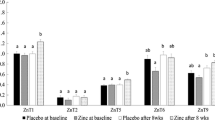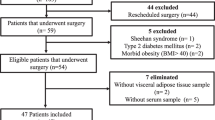Abstract
Obesity, a chronic inflammatory state, is associated with altered zinc metabolism. ZnT and Zip transporters are involved in the regulation of zinc metabolism. This study examined the relationships among obesity, zinc transporter gene expression, and inflammatory markers in young Korean women. The messenger RNA (mRNA) levels of leukocyte zinc transporters between obese (BMI = 28.3 ± 0.5 kg/m2, n = 35) and nonobese (BMI = 20.7 ± 0.2 kg/m2, n = 20) women aged 18–28 years were examined using quantitative real-time polymerase chain reaction. Inflammatory markers, such as C-reactive protein (CRP), tumor necrosis factor-alpha (TNF-α), and interleukin (IL)-6, were measured in serum by enzyme immunoassay. ZnT1 and Zip1 were the most abundantly expressed zinc transporters in leukocytes. The mRNA levels of many zinc transporters (ZnT4, ZnT5, ZnT9, Zip1, Zip4, and Zip6) were significantly lower in obese women, and expression of these genes was inversely correlated with BMI and body fat percentage. In addition, inflammatory markers (CRP and TNF-α) were significantly higher in obese women. The mRNA levels of ZnT4, Zip1, and Zip6 were inversely correlated with CRP (P < 0.05), and mRNA levels of ZnT4 and ZnT5 were inversely correlated with TNF-α (P < 0.05). In standardized simple regression models, levels of TNF-α and CRP were negatively associated with mRNA levels of zinc transporters such as ZnT4, ZnT5, Zip1, and Zip6 (P < 0.05). These results suggest that the expression of zinc transporters may be altered in obese individuals. Changes in zinc transporters may also be related to the inflammatory state associated with obesity.

Similar content being viewed by others
Reference
Caballero B (2007) The global epidemic of obesity: an overview. Epidemiol Rev 29:1–5
Bastard JP, Maachi M, Lagathu C, Kim MJ, Caron M, Vidal H, Capeau J, Feve B (2006) Recent advances in the relationship between obesity, inflammation, and insulin resistance. Eur Cytokine Netw 17(1):4–12
Marreiro DN, Geloneze B, Tambascia MA, Lerario AC, Halpern A, Cozzolino SM (2006) Effect of zinc supplementation on serum leptin levels and insulin resistance of obese women. Biol Trace Elem Res 112(2):109–118
Tungtrongchitr R, Pongpaew P, Phonrat B, Tungtrongchitr A, Viroonudomphol D, Vudhivai N, Schelp FP (2003) Serum copper, zinc, ceruloplasmin and superoxide dismutase in Thai overweight and obese. J Med Assoc Thai 86(6):543–551
Ennes Dourado Ferro F, de Sousa Lima VB, Mello Soares NR, Franciscato Cozzolino SM, do Nascimento Marreiro D (2011) Biomarkers of metabolic syndrome and its relationship with the zinc nutritional status in obese women. Nutr Hosp 26(3):650–654
Begin-Heick N, Dalpe-Scott M, Rowe J, Heick HM (1985) Zinc supplementation attenuates insulin secretory activity in pancreatic islets of the ob/ob mouse. Diabetes 34(2):179–184
Foster M, Samman S (2012) Zinc and regulation of inflammatory cytokines: implications for cardiometabolic disease. Nutrients 4(7):676–694
Garcia OP, Ronquillo D, Caamano Mdel C, Camacho M, Long KZ, Rosado JL (2012) Zinc, vitamin A, and vitamin C status are associated with leptin concentrations and obesity in Mexican women: results from a cross-sectional study. Nutr Metab (Lond) 9(1):59
Freire SC, Fisberg M, Cozzolino SM (2013) Dietary intervention causes redistribution of zinc in obese adolescents. Biol Trace Elem Res 154(2):168–177
Lichten LA, Cousins RJ (2009) Mammalian zinc transporters: nutritional and physiologic regulation. Annu Rev Nutr 29:153–176
Andree KB, Kim J, Kirschke CP, Gregg JP, Paik H, Joung H, Woodhouse L, King JC, Huang L (2004) Investigation of lymphocyte gene expression for use as biomarkers for zinc status in humans. J Nutr 134(7):1716–1723
Overbeck S, Uciechowski P, Ackland ML, Ford D, Rink L (2008) Intracellular zinc homeostasis in leukocyte subsets is regulated by different expression of zinc exporters ZnT-1 to ZnT-9. J Leukoc Biol 83(2):368–380
Aydemir TB, Blanchard RK, Cousins RJ (2006) Zinc supplementation of young men alters metallothionein, zinc transporter, and cytokine gene expression in leukocyte populations. Proc Natl Acad Sci U S A 103(6):1699–1704
Smidt K, Pedersen SB, Brock B, Schmitz O, Fisker S, Bendix J, Wogensen L, Rungby J (2007) Zinc-transporter genes in human visceral and subcutaneous adipocytes: lean versus obese. Mol Cell Endocrinol 264(1–2):68–73
World Health Organization (WHO) (2000) The Asia Pacific perspective: redefining obesity and its treatment
World Health Organization (WHO) (2008) Waist circumference and waist-hip ratio: report of a WHO expert consultation
Pickering TG, Hall JE, Appel LJ, Falkner BE, Graves J, Hill MN, Jones DW, Kurtz T, Sheps SG, Roccella EJ (2005) Recommendations for blood pressure measurement in humans and experimental animals: Part 1. Blood pressure measurement in humans: a statement for professionals from the Subcommittee of Professional and Public Education of the American Heart Association Council on High Blood Pressure Research. Hypertension 45(1):142–161
Kim J, Paik HY, Joung H, Woodhouse LR, Li S, King JC (2004) Zinc supplementation reduces fractional zinc absorption in young and elderly korean women. J Am Coll Nutr 23(4):309–315
Jacobs RM, Lumsden JH, Taylor JA, Grift E (1991) Effects of interferents on the kinetic Jaffe reaction and an enzymatic colorimetric test for serum creatinine concentration determination in cats, cows, dogs and horses. Can J Vet Res 55(2):150–154
Koenig W, Lowel H, Baumert J, Meisinger C (2004) C-reactive protein modulates risk prediction based on the Framingham score: implications for future risk assessment: results from a large cohort study in southern Germany. Circulation 109(11):1349–1353
Idriss HT, Naismith JH (2000) TNF alpha and the TNF receptor superfamily: structure–function relationship(s). Microsc Res Tech 50(3):184–195
Murakami M, Hibi M, Nakagawa N, Nakagawa T, Yasukawa K, Yamanishi K, Taga T, Kishimoto T (1993) IL-6-induced homodimerization of gp130 and associated activation of a tyrosine kinase. Science 260(5115):1808–1810
Ozata M, Mergen M, Oktenli C, Aydin A, Sanisoglu SY, Bolu E, Yilmaz MI, Sayal A, Isimer A, Ozdemir IC (2002) Increased oxidative stress and hypozincemia in male obesity. Clin Biochem 35(8):627–631
Marreiro DN, Fisberg M, Cozzolino SM (2004) Zinc nutritional status and its relationships with hyperinsulinemia in obese children and adolescents. Biol Trace Elem Res 100(2):137–149
Marotta A, Todisco N, Di Toro A, Toraldo R, Ponte G, Perrone L (1995) Zinc content of lymphomonocytes in obese children. Nutr Res 15(10):1411–1415
Huang L, Yu YY, Kirschke CP, Gertz ER, Lloyd KK (2007) Znt7 (Slc30a7)-deficient mice display reduced body zinc status and body fat accumulation. J Biol Chem 282(51):37053–37063
Lang C, Murgia C, Leong M, Tan LW, Perozzi G, Knight D, Ruffin R, Zalewski P (2007) Anti-inflammatory effects of zinc and alterations in zinc transporter mRNA in mouse models of allergic inflammation. Am J Physiol Lung Cell Mol Physiol 292(2):L577–L584
Palmiter RD, Huang L (2004) Efflux and compartmentalization of zinc by members of the SLC30 family of solute carriers. Pflugers Arch 447(5):744–751
Lee DY, Shay NF, Cousins RJ (1992) Altered zinc metabolism occurs in murine lethal milk syndrome. J Nutr 122(11):2233–2238
Murgia C, Vespignani I, Rami R, Perozzi G (2006) The Znt4 mutation inlethal milk mice affects intestinal zinc homeostasis through the expression of other Zn transporters. Genes Nutr 1(1):61–70
Cassel GH (1978) Zinc: a review of current trends in therapy and our knowledge of its toxicity. Del Med J 50(6):323–328
Kelishadi R, Hashemipour M, Adeli K, Tavakoli N, Movahedian-Attar A, Shapouri J, Poursafa P, Rouzbahani A (2010) Effect of zinc supplementation on markers of insulin resistance, oxidative stress, and inflammation among prepubescent children with metabolic syndrome. Metab Syndr Relat Disord 8(6):505–510
Huang L, Kirschke CP, Zhang Y, Yu YY (2005) The ZIP7 gene (Slc39a7) encodes a zinc transporter involved in zinc homeostasis of the Golgi apparatus. J Biol Chem 280(15):15456–15463
Kitamura H, Morikawa H, Kamon H, Iguchi M, Hojyo S, Fukada T, Yamashita S, Kaisho T, Akira S, Murakami M, Hirano T (2006) Toll-like receptor-mediated regulation of zinc homeostasis influences dendritic cell function. Nat Immunol 7(9):971–977
Kim J (2013) Dietary zinc intake is inversely associated with systolic blood pressure in young obese women. Nutr Res Pract 7(5):380–384
Cousins RJ, Liuzzi JP, Lichten LA (2006) Mammalian zinc transport, trafficking, and signals. J Biol Chem 281(34):24085–24089
Acknowledgments
This research was supported by the Basic Science Research Program of the National Research Foundation of Korea (NRF) founded by the Ministry of Education, Science, and Technology (NRF-2010-0011226 to J.C. and NRF2012R1A1A1012317 to J.K.).
Author information
Authors and Affiliations
Corresponding authors
Rights and permissions
About this article
Cite this article
Noh, H., Paik, H.Y., Kim, J. et al. The Alteration of Zinc Transporter Gene Expression Is Associated with Inflammatory Markers in Obese Women. Biol Trace Elem Res 158, 1–8 (2014). https://doi.org/10.1007/s12011-014-9902-1
Received:
Accepted:
Published:
Issue Date:
DOI: https://doi.org/10.1007/s12011-014-9902-1




